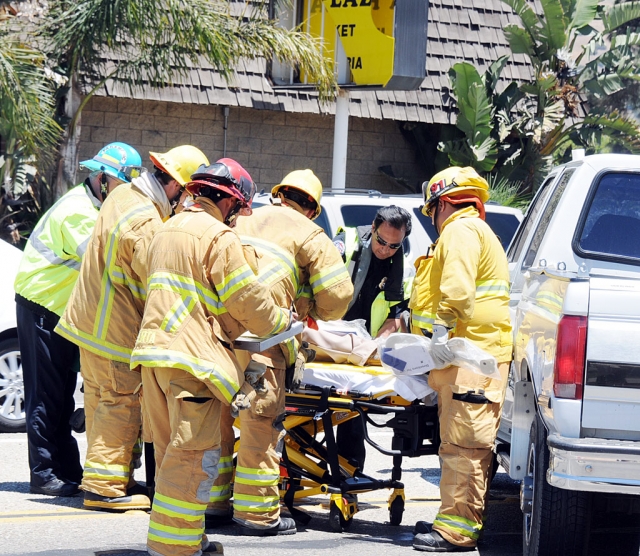|
By Anonymous — Wednesday, June 27th, 2012
C Street and Highway 126
 A serious accident occurred at the intersection of C Street and Highway 126, Saturday. A pickup and a Honda were involved in a head-on collision at about 10:30 a.m. The male driver of the pickup was transported to hospital by ambulance. No report was available on the condition of the driver of the Honda or the pickup. Extensive damage was done to both vehicles. Enlarge Photo |
|
By Anonymous — Wednesday, June 27th, 2012
3rd Street
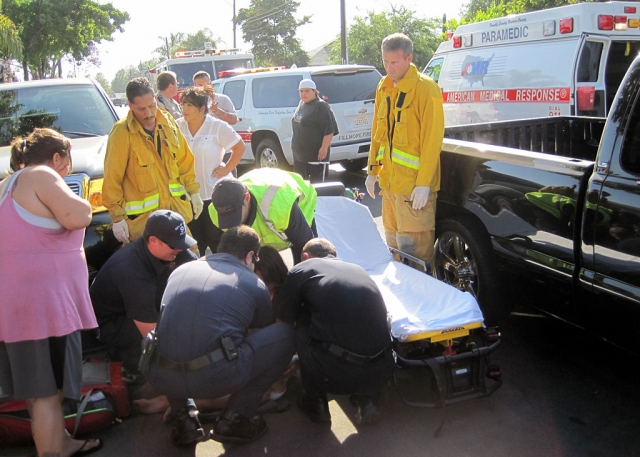 Fillmore Fire Department, Ventura County Sherriff Department and AMR Ambulance responded to a Traffic Collision on the 700 block of 3rd Street. Fillmore Fire and AMR personnel treated and transported a teenage girl who was struck by a pickup truck traveling east bound on 3rd Street. Enlarge Photo 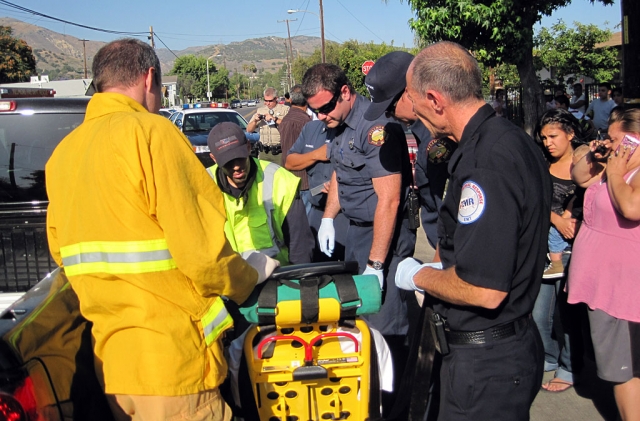 Patient was transported to Ventura County Medical Center with a fractured leg. Unknown of any other injuries. Photos courtesy Rigo Landeros, Fire Chief. Enlarge Photo |
|
By Anonymous — Tuesday, June 26th, 2012
Police seek information from public
On Sunday June 24th, 2012, at approximately 5:03am officers responded to the Texaco Gas Station located at 206 E. Harvard Blvd. for the report of an armed robbery. The suspect entered the business brandishing a knife and demanded money. An unknown amount of money was taken and the suspect fled east through the parking lot. The suspect was described as a male subject, thin build, approximate 5-11, wearing unknown clothing. The area was checked by officers from the Santa Paula Police Department as well as K-9 deputies from the Ventura County Sheriffs Department. However they did not located the suspect. At this time the investigation is ongoing. |
|
By Anonymous — Tuesday, June 26th, 2012
 On Saturday June 23rd Fillmore Fire Department and Ventura County Sheriff’s Department responded to a traffic collision on the 900 block of Ventura St. This was a two vehicle accident with minor injuries. Enlarge Photo 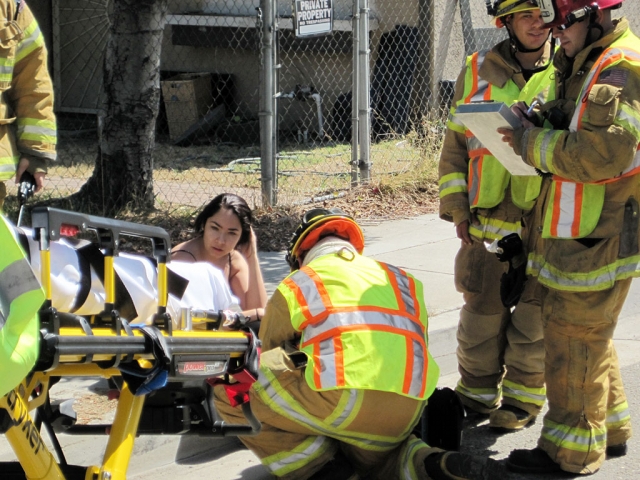 One pregnant female was transported to Santa Paula to be check out for any complications. No other injuries were reported. Photo's courtesy Rigo Landeros, Fire Chief, City of Fillmore Fire Dept. Enlarge Photo |
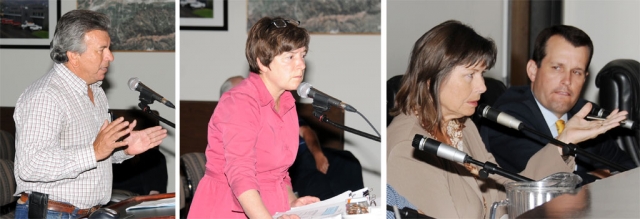 Photos (l-r) Former Mayor Evaristo Barajas told the council that city finances were healthy when they took over. Councilman Jamey Brooks has a habit of blaming past councils for this council’s inept decisions.; City Manager Yvonne Quiring tries to explain the city deficit by using a pennies-in-a-jar demonstration.; Mayor Gayle Washburn had little reaction to Citizen Steve Conaway’s rebuke for her action in telling the city attorney he could no longer attend meetings. Enlarge Photo By Anonymous — Wednesday, June 20th, 2012
Unprecedented Action Sparks Condemnation from Conaway
Meeting Highlights Video Complete meeting video What began as a normal city council meeting, Tuesday, quickly exploded into verbal fireworks from Steve Conaway, a seven-plus year councilman, as he condemned Mayor Washburn for her unprecedented conduct. Last Monday Washburn called the city attorney’s office, informing a member of that firm that Fillmore’s City Attorney, Ted Schneider, was no longer to attend any city meetings. It is alleged that her justification for banning Schneider was based on accusations that he has had a relationship with a former city employee. Conaway expressed outrage with this action, stating that neither the Mayor nor the City Manager, Yvonne Quiring, had any business taking such action, implying a lack of authority to do so. Conaway said it was nothing less than “a personal vendetta being executed” against Schneider, and that “an individual’s personal life is none of your business.” Quiring was silent. Washburn CONTINUED » |
 Outside of Vons Supermarket Captain Al Huerta, along with a team member, shows citizens how to perform the new “Hands-Only” CPR. Enlarge Photo By Anonymous — Wednesday, June 20th, 2012
On Thursday, June 7th, the Ventura County Emergency Medical Services Agency partnered with the American Heart Association to coordinate a county-wide CPR program. This service was free to the public and was held in various locations across Southern California, Including Fillmore, with the goal of increasing the number of lifesavers in the community. Emergency healthcare providers, such as fire departments, ambulance companies, hospitals - Ventura County Medical Center, Santa Paula Hospital, Los Robles Hospital, Community Memorial Hospital and St. John's Hospital — and education programs went out into the community to teach residents how to save a life with "Hands-Only" CPR. CPR instructors were on hand to demonstrate the basics and proper techniques of "Hands-Only" CPR, and participants had the opportunity to practice on mannequins. The training did not result in CPR certification. Sadly, 70 percent CONTINUED » |
|
By Anonymous — Wednesday, June 20th, 2012
Story Courtesy goventura.org VISTA bus riders may soon encounter some service disruption arising from recent bankruptcy proceedings associated with service contractor CUSA. “Within the past two days, representatives from CUSA which operates our popular VISTA inter-community bus service informed the Commission that it intends to halt operations on or about June 30, 2012 due to bankruptcy sale of assets. We clearly understand the negative impact which this action may have on our valued VISTA customers, and VCTC staff is working actively to identify a safe and quality solution”, noted Darren Kettle, VCTC Executive Director. Any possible disruption in CUSA operations would not have an impact on VISTA dial-a-ride services in the Heritage Valley (Santa Paula, Fillmore, and Piru); nor on any of Ventura County’s other public transit providers: Ojai Trolley, Moorpark City Transit, Gold Coast Transit, Thousand Oaks Transit, Camarillo Area Transit, and Simi Valley Transit. About 1,500 passengers are served daily through VISTA. VCTC will continue to honor all Go Ventura bus pass cards on the VISTA inter-community bus service through June 30, 2012. Go Ventura bus pass products will continue to be honored on other participating public transit providers throughout Ventura County, including VISTA dial-a-ride services in the Heritage Valley (Santa Paula, Fillmore and Piru). New sale and CONTINUED » |
|
By Anonymous — Wednesday, June 20th, 2012
 Captain Al Huerta brought a 3-year old Rattlesnake into the Gazette on Monday. The snake was found by a gardener off of Goodenough Road. This is a good reminder to be careful when you are doing yardwork. Enlarge Photo |
 Fillmore resident Joan Archer took Fillmore City Manager Yvonne Quiring to task at Tuesday’s City Council meeting. Archer found serious problems with Quiring’s handling of employee layoffs in that Quiring could not account for any savings to the city in hiring temporary and contract substitute workers. Enlarge Photo By Anonymous — Wednesday, June 13th, 2012
[The Gazette’s city reporter was absent this week] For the second week chambers was filled with concerned citizens responding to expressed intentions by the council to close Fillmore’s parks and restrooms. City Manager Quiring suggested last week that, because Fillmore is such a small town, those participating in sporting events at the parks could run home to use bathroom facilities. Councilman Steve Conaway expressed frustration in the Manager’s inability to provide specific answers to budget questions and time is very short for the mandated budget approval. |
 (l-r) Volunteers: Bill Dewey, Edward Barajas, Victor Kreider, Ricardo Miranda, James Doran, who donates his truck every week to pick up the food. Community Food Distribution is sustained through small grants and donations by Trinity Episcopal Church. Enlarge Photo By Jean McLeod — Wednesday, June 13th, 2012
Throughout Ventura County the number of people needing help feeding their families continues to grow. Food Share of Ventura County, which was established in 1983, helps address this need with its 150 partnered outreach agencies and over 300 volunteers. In 2010 Food Share distributed over nine million pounds of food to more than 74,500 people each month countywide. This number represents more than 6.8 million meals. Volunteers are a huge part of all the programs along with faith based organizations that provide 67% of the distribution outreach and non-profits which provide about 25%. The primary source of food products made available are through donations from local grocery stores, supermarket chains, food manufacturers, distributors, the government, foundations, local farmers, harvesting efforts, food drives and private individuals. One of the biggest food drives, The Postal Carriers’ Food Drive, was recently held. This drive allows the citizens of the county to donate food on a designated Saturday, which was May 12th this year, by putting the items out for their mail carrier to collect and bring back to the local post office. Those items are then distributed to outreach programs. Bonnie Weigel, CEO and CONTINUED » |




